|
An Interesting Product Feature
Many thanks to Michael King for sharing
this great story with Chapter Chatter. His story is a prime
example of why companies should focus on their core competencies,
when at all possible. Michael is a Senior EMC Consultant
from Southern California.
In 1969, there were many firsts in systems,
especially with the commercialization of integrated circuit
devices and technologies that fell out of the NASA space
program. Examples were “the first” hand-held scientific
calculators (then called electronic slide rules) and the
first point-of-sale (POS) terminal systems in retail stores.
One very large, very well known, department store chain
decided to establish their own computer development department.
The aforementioned department store chain was not content
to acquire point-of-sales systems from established technology
enterprises. One interesting feature of their design approach
was to build their POS terminals in wooden cases clad with
Formica.
When these systems were deployed, the
commercial environment EMC naiveté of systems engineers
(who had turned commercial from government systems, where
the environment was understood) became instantly revealed!
When the “home-brewed” POS computers were deployed
alongside traditional cash registers, the POS computers
exhibited the fascinating habit of spontaneously and randomly
(it would seem) opening the cash drawers. After many difficult
months of design-evaluation effort, the design team concluded
that transients were causing the “flying open cash
drawers.” Evaluation proved that the POS computers
demonstrated a high probability to fail ESD thresholds somewhere
below a 500 Volt threshold. Furthermore, failure could be
caused by an ESD event applied to any conductive structure
within a radius of about two meters!
One can just imagine the defense posture of a thief standing
before a judge, “Gee, your Honor, I didn't do anything!
I walked by and it just offered me its money!” About
2,000 systems were installed before the problem was identified
and addressed. Mike only wishes that his evaluation and
retrofit fee could have been based on the funds not stolen
as a result of the ESD fix.
|
Boston (Central New England)
The Central New England Chapter has held one meeting since the
Summer 2003 issue of Chapter Chatter. The Chapter held its 8th
annual joint meeting with the Northeast Product Safety Society
on Wednesday, September 24. 35 EMCS and NPSS members and guests
attended the traditional joint meeting, which dates back to September
1997. The speaker was Isidor Straus, founder with Jon Curtis of
Curtis-Straus, LLC, Littleton, Massachusetts. He was also the
speaker for the first of these annual events in September 1997.
The topic presented was “PCBs and EMC Noise Suppression.”
An overview of major issues included basic emissions mechanisms;
emissions mechanisms and models; PCB methods to limit loop area
and common mode voltage buildup; transmission lines in PCB design;
and coupling (cross-talk noise propagation). Some of the special
examples that were illustrated included LAN interface layout with
EMI control and ESD precautions. Isidor Straus has been active
in the field of regulatory compliance for over 25 years. He is
also an editor and frequent contributor to Conformity Magazine.
Much of his current work involves correction of EMC design problems
and emissions control. Mr. Straus is an IEEE EMC Society member
and served as Technical Committee Co-Chair for the 2003 IEEE Symposium
on EMC held in Boston on August 18-22. The CNE Chapter’s
next meeting will be held on December 4th. The speaker will be
a current Distinguished Lecturer of the EMC Society, Professor
Michel Ianoz of the Swiss Institute of Technology in Lausanne,
Switzerland where he teaches EMC as a member of the Electrical
Engineering Department. The topic will be “Lightning Electromagnetic
Effects.”
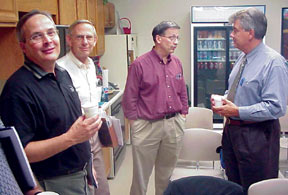 |
| From the Chicago Chapter (from left):
Ray Klouda, Chapter Chair, Bob Hofmann, resident EMC guru,
Tom Braxton, 2005 Symposium Chairman, and Frank Krozel, MiniSymposium
Chairman. |
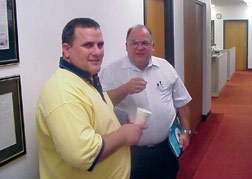 |
| Pictured from the Chicago Chapter
are David Anthony of X2Y Attenuators (left) and Dennis Stephens
of Motorola. |
 |
| Chicago Chapter members enjoy the
first meeting after the summer break. Jack Prawica of DLS
Electronic Systems (from left) visited with speaker Jim Muccioli
of X2Y Attenuators, Brian Mattson of DLS Electronic Systems,
and John Koklys of Motorola at the September meeting. |
Chicago
The Chicago Chapter held its first meeting of the new EMC year
in September. The meeting, held at DLS Electronics in Wheeling,
was well attended and enjoyed by all. The presenter was Jim Muccioli
of X2Y Attenuators. He was joined in the presentation by a few
of his local customers. Many thanks to DLS Electronics for graciously
hosting and feeding the group!
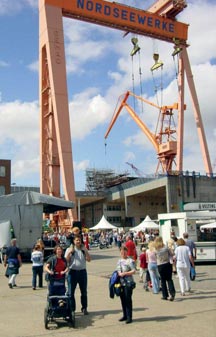 |
| Dr. Sabath and family visited the
famous Nordseewerke GmbH shipyard, which hopefully will host
an “EMC in Maritime Applications” Chapter meeting
in the near future. |
 |
| The EUROEM 2004 Steering Committee
met in July to discuss the technical theme of their upcoming
event. |
Germany
Dr. Heyno Garbe, the chairman of the German
Chapter, and Dr. Frank Sabath, the new regional conference coordinator
in region 8, met on August 15th. Major topics of this meeting
were the future activities of the German Chapter, the organization
of the upcoming EUROEM 2004 in Magdeburg, the development of regional
events on EMC and the impact of Dr. Sabath’s new position
on the work of the German Chapter, particularly the support that
will be given by the Chapter to the regional conference coordination
committee. As Dr. Sabath invited the German Chapter to organize
and host regional events, both Dr. Garbe and Dr. Sabath agreed
upon a regional workshop, with a theme of numerical field computation.
The workshop, which will headline Dr. Tapan Sakae of Syracuse
University, is scheduled to be held on July 12th, 2004 at the
Otto-von-Guericke-University Magdeburg, Germany. The second day
of the meeting was closed by a visit to the Nordseewerke GmbH
shipyard in Emden on August 16th. Various engineering aspects
of the design of modern surface and underwater vessels were presented
at numerous stations. The broad spectrum of EMC related items
impressed the officers of the German Chapter. They asked Dr. H.
Hansen, an EMC expert at Nordseewerke, to organize a chapter meeting
on EMC aspects of maritime systems, hosted by the Nordseewerke
GmbH shipyard. During a meeting of the EUROEM 2004 steering committee
(held at Magdeburg), Dr. Garbe congratulated Dr. Nitsch, chair
of the EUROEM 2004, on the technical co-sponsorship of the EMC
Society. The German Chapter is strongly involved in EUROEM 2004,
to be held on July 12 – 16, 2004 at the Otto-von-Guericke-University
Magdeburg. Ten of the thirteen members of the steering committee
are members of the German Chapter. In addition, the Chapter is
organizing a special session on UWB susceptibility, which will
be chaired by Dr. H. Garbe and D. Nitsch.
Korea
Professor Dong Il Kim (Korea Maritime University), Chairperson
of the Korea EMC Chapter, reports that the Korea Chapter hosted
the “2003 Workshop on Antenna Technology.” The workshop
was held at the Seoul Education Center on April 25. Included were
six presentations covering various aspects of the antenna. Of
special interest was Professor K. Kagoshima’s paper titled,
“Antenna Technologies for Wireless Networks and Services:
Past, Present and Future.” 100 participants attended the
workshop which was coordinated by the Korea Electromagnetic Engineering
Society (KEES) and the IEEE AP/MTT Korea Chapter. The Korea Chapter
also held the “2003 Spring Conference on Microwave/Radio”
at the University of Seoul on May 24. Approximately 150 papers
presented at the conference covered the various aspects of the
electromagnetic field including the active/passive circuits and
components, EMI/EMC, antenna, scattering, and so on. Some 300
participants attended this conference, which was also coordinated
by KEES and the IEEE AP/MTT Korea Chapter. Plans are currently
being made for the Korea Chapter to hold the “2003 KOREA
EMC Workshop” at the Seoul Education Center on October 16.
This event will be also coordinated by KEES.
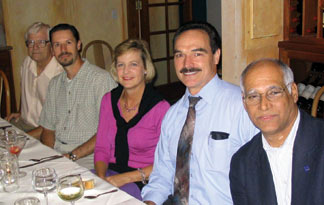 |
| A dinner was held to celebrate the
success of the Los Angeles and Orange County Chapter seminar.
Joining in the celebration are (from left) Rick Mahoney of
Aerospace Corporation, speaker James Young, Janet O’Neil
who coordinated the seminars held in Los Angeles and San Diego,
John O’Brien of WEMS Electronics whose facility is the
location of the Los Angeles Chapter’s monthly meetings,
and Kanaiya Mahendra of Aerospace Corporation. |
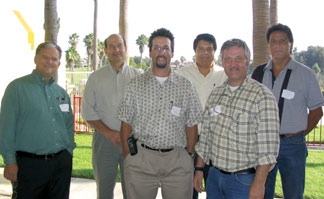 |
| Allen Fischer of Fischer Custom Communications
(far left) took in some California sunshine during a break
in the seminar’s technical program. He is joined by (from
left) Bob McKinney, Hugh Oliveto, Rudy Mendiola, and Charles
Pollard, all with Boeing Satellite Systems, and Chris Skillens
of Raytheon. |
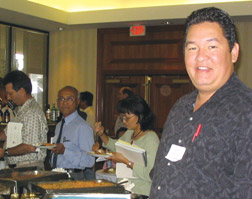 |
| Robert Tozier of CKC Labs, Chairman
of the Orange County Chapter, enjoyed the buffet held during
the reception following the half-day seminar. Attendees could
network, eat, drink and watch demos during the one-hour reception! |
 |
| Ray Adams did double duty at the
Los Angeles and Orange County Chapters half-day seminar “How
to Improve the Accuracy of EMC Measurements.” Ray is
the Los Angeles Chapter Chairman and was one of the seminar
speakers. He is shown “warming up” the crowd of
some 60 EMC professionals. |
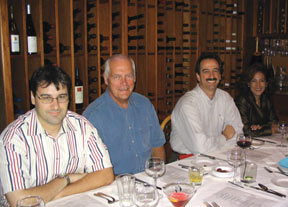 |
| Enjoying the ambiance of the “Wine
Room” at Café Pierre in Manhattan Beach are (from
left) Vince Rodriguez, speaker, Paul Gregory of ETS-Lindgren
who coordinated the demonstrations for the seminar, and Mr.
and Mrs. Ray Adams. |
 |
| Time to relax! John Whitney and Rodger
Gensel of Amplifier Research join Gene Taylor of Altamont
Technical Services (from left) at the Los Angeles and Orange
County Chapter dinner. Gene handled the registration for the
seminars in Los Angeles and San Diego. |
Los Angeles and Orange County
What started out over dinner as a complaint about the problems
associated with EMC measurements became the event “How to
Improve the Accuracy of EMC Measurements.” This half-day
seminar on September 25, held at the Marriott Hotel in Manhattan
Beach, was organized by the Los Angeles and Orange County EMC
Chapters and featured four speakers, including Los Angeles Chapter
Chair Ray Adams of Boeing Satellite Systems. The seminar began
after lunch with a kick off presentation by Rodger Gensel of Amplifier
Research who spoke on RF Conducted and Transient Disturbance Testing.
Next, Ray Adams spoke on the topic Radiated Susceptibility/Immunity.
Vince Rodriguez of ETS-Lindgren then addressed Reverberation Chamber
Test Methodologies and finally, James Young of Rohde & Schwarz
discussed Radiated Emissions. Robert Tozier of CKC Labs, Chair
of the Orange County Chapter, was on hand to present attendees
with “official” certificates of completion. A reception
was held following the seminar with the speakers each conducting
demonstrations of the material presented. Attendees were treated
to heavy appetizers and drinks courtesy of Amplifier Research,
ETS-Lindgren, Rohde & Schwarz, and Altamont Technical Sales.
This provided a wonderful opportunity to informally visit with
the speakers, view demonstrations and enjoy good food and drink
while waiting out the notorious Los Angeles traffic. Those in
attendance agreed the seminar was not only thought provoking,
but provided practical tips and techniques for conducting accurate
EMC measurements. Over 60 chapter members and guests attended
the seminar.
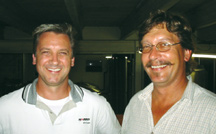 |
| Melbourne Chapter Chair Chris Maginsky
(right) welcomes EMC Society member Joe Marcoux to the September
meeting. |
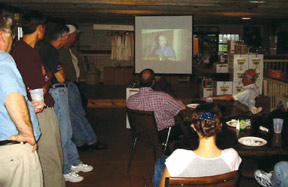 |
| The Melbourne EMC Chapter listens
to some “EMC War Stories,” courtesy of a video provided
by the EMC Society. |
Melbourne
On September 24, the Melbourne EMC Chapter
hosted a technical meeting at the Indian River Brewing Company
in Melbourne, Florida. Chris Maginsky of Northrop Grumman, this
year’s EMC Chapter Chair, kicked-off the meeting by welcoming
the guests to dinner. After everyone had their fill of pizza and
cold drinks, the guests participated in a technical forum. The
catalyst for the discussion, and the highlight of the meeting,
was a viewing of the excellent video, “EMC War Stories”.
This video, produced by the IEEE EMC Society, included interesting
and entertaining EMC tales as told by some renowned EMC engineers.
Special thanks go to Dick Ford for doing a great job putting the
video together. After viewing the video, the meeting guests took
turns discussing their own EMC war stories; not surprisingly,
almost everyone had at least one! This meeting was a fun addition
to the Melbourne Chapter’s 2003 activities, and we’re
already planning ways to make 2004 another great year.
Nanjing
On September 16, a packed house of 64 members and guests attended
a double-header meeting with two great presentations. The first
was by Professor Ru-Shan Chen entitled “Precondition Techniques
in Computational Electromagnetics.” Professor Chen hails
from the Department of Electrical Engineering at the Nanjing University
of Science and Technology. Professor Wan-Chun Tang also of the
Nanjing University of Science and Technology delivered the second
half of the double-header. Professor Wan-Chun’s presentation
was entitled “Microwave Integrated Circuit CAD Using Fuzzy
Electromagnetics.” On September 26, another large group gathered
to hear Bin-Fa He, Senior Engineer, give a presentation on “Antenna
Measurement Techniques.” The same evening, Professor Xiao-Wei
Zhu spoke to the large turnout about the broadband linearization
techniques of an RF power amplifier. Both presentations were well
received and enjoyed by all who attended.
Oregon-Southwest Washington
Dave Britton, the Vice Chair of the Oregon and SW Washington Chapter,
reports that the Chapter has established a great meeting schedule
for the coming season, including:
-
29 September, 2003 –
Chris Kendall of CKC Labs
-
29 October, 2003 –
Varuzhan Kocharyn from Northwest EMC
-
19 November 2003 –
Franz Gisin from Sanmina Corp.
-
December, 2003 – Holiday
Social at TBD
-
20 January, 2004 –
Road trip to the Seattle Chapter Colloquium
-
25 February, 2004 –
TBD
-
24 March, 2004 – TBD
-
27 April, 2004 – C.W.
Lam from Apple Computer
-
26 May, 2004 – TBD
On August 3, the incoming and outgoing officers
of the local EMC Chapter and the Product Safety Technical Committee
(PSTC) had a joint picnic. All enjoyed good fun and food. For
details on the above meetings and to RSVP, check our website at:
https://www.worldaccessnet.com/~emc/
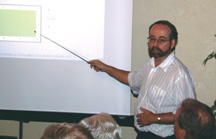 |
| Harry Gaul of General Dynamics Decision
Systems highlights the need to bond the digital return plane
with screws to the chassis at multiple points around the periphery
of the PC board at the Phoenix Chapter meeting. |
Phoenix
Glen Gassaway reports that the Phoenix Chapter had very good attendance
at the September 25 meeting held at Garcia’s Mexican Restaurant
in Tempe! The meeting room was filled to capacity as usual. The
social hour consisted of the traditional war-stories as everyone
sat down together for another great Mexican food dinner. Harry
Gaul brought the meeting to order at 7:00 pm. As those in attendance
introduced themselves, they realized that we had a very good representation
of many companies around the Valley. Harry made the formal announcement
that we won the IEEE EMC Chapter-of-the-Year Award at the Boston
symposium. Harry specifically pointed out that, while we all work
to make the chapter a rousing success, we owe a lot to Terry Donohoe,
our first chapter chairman (thanks Terry!). Once the commotion
subsided, it was time for Glen to introduce Harry as the featured
speaker of the evening. The presentation title was “EMC Design
Considerations for PCB Layout” or, in more basic terms, “PCB
Layout for Dummies!” Harry presented a very practical approach
to EMC design for PC boards. The agenda included component placement,
grounding, proper use of bypass caps, transmission line theory,
clock and digital line filtering, trace spacing, optimum PCB stack-up
and auto routing techniques. In addition to signal integrity issues,
proper PC layout is necessary to meet regulatory requirements
(such as FCC/CE Mark or DO-160). Component placement issues include
partitioning, separation of noisy versus susceptible components
and minimization of clock trace lengths. Harry also covered grounding
philosophies of single point grounds and multi-point grounds.
Hybrid grounds were discussed. Also mentioned was the proper placement
of bypass caps; do you place them near VCC or GND? Of course,
the answer is: it depends! The methods in which one could calculate
the transmission line impedance given board type and trace physical
dimensions were discussed, in addition to the proper termination
of clock and high speed digital line traces. The book entitled
“High Speed Signal Propagation: Advanced Black Magic”
by Howard Johnson was recommended as an excellent source of digital
PC board design. Trace placement, separation and PCB stack-up
were all discussed at length. Various example stack-ups were given
for 6, 8 and 10 layer boards. The considerations given to the
use of auto routers included identifying the threat signals, performing
manual routing on them, protecting them using the ‘protect’
feature and then allowing the auto router to complete the task.
In concluding the talk, Harry said that we should follow Todd
Hubing’s four important points: 1) Keep loop areas small,
2) Don’t locate circuitry between connectors, 3) Control
transmission rise times in digital circuits and 4) Never (or almost
never) put gaps in solid ground planes! The audience was very
attentive and interactive and several comments were elicited throughout
the presentation. The most engaging comment was: “EMI Engineers
should have the duty and the right to beat the #&%! out of
digital designers that don’t follow these rules.” That
comment brought the house down! The presentation materials from
this meeting as well as announcements for future meetings are
available on the Phoenix EMC Chapter Web site at https://www.ewh.ieee.org/r6/phoenix/phoenixemc/.
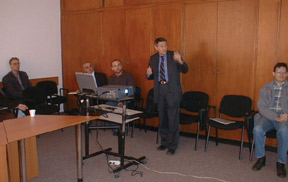 |
| EMCS Distinguished Lecturer Michel
Ianoz gave a presentation to the new Romania Chapter in March. |
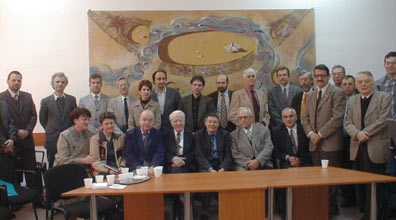 |
| Several engineers, professors and
students are shown in Bucharest for the series of lectures
given by Professor Michel Ianoz in March. |
Romania
On March 24, the new Romanian EMC Chapter
enjoyed an important event! Professor Michel Ianoz, EMC Society
Distinguished Lecturer, gave EMC lectures to a good turnout of
24 engineers, professors and students in Bucharest. Since being
formed in late 2002, the Romanian EMC Chapter and its Chairman,
Professor A. Marinescu, have tried to initiate interesting activities
for its members. This has taken place in spite of financial difficulties,
which can make travel from one town to another a problem for Romanian
IEEE EMC Society members. The lectures on March 24 were organized
at the Faculty of Electrotechnics of the University “Politechnica”
of Bucharest. This was the first time a lecture was delivered
to the Romanian EMC Chapter by a Distinguished Lecturer. Professor
M. Ianoz presented two lectures. His morning presentation was
entitled, “EMC problems related to transient phenomena in
the power network substations” and his afternoon presentation
was entitled, “Biological effects of electromagnetic fields.”
The cities of Bucharest and Craiova are strong centers of the
electric power industry and the lecture subject was chosen taking
into account this aspect. Among those who attended was Professor
Gleb Dragan, a member of the Romanian Academy of Science, the
founder of EMC activity in Romania. Very exciting discussions
took place, not only during the lectures, but also during the
lunch break. Two days later on March 26, Professor Ianoz presented
again the lecture on “Biological effects of electromagnetic
fields” at the University “Gh. Asachi” in the town
of Lassy. 26 were in attendance, most being students and not current
IEEE members. In Lassy, the lecture was also followed by very
exciting discussions, as the subject matter is very controversial.
Attendees agreed that even if there is currently no definite scientific
evidence that the fields are or are not harmful to health, the
EMC community should keep abreast of the latest research developments.
The Romanian EMC Chapter has 21 members, largely concentrated
in the capital Bucharest, and in four industrial and university
centers Craiova, Brasov, Timisoara and Cluj. In this context,
the organization of the lectures with the support of the EMC Society
and ACER (Romanian EMC Association) was an event that contributed
to an increase in interest in this field. Various activities have
increased EMC interest in Romania. First, Professor A. Marinescu
is also Executive President of ACER (Romanian EMC Association)
a professional association of 118 members founded in 1997 as a
non - governmental, non - profit association having its headquarters
at ICMET Craiova. Next, the building of an EMC accredited test
laboratory in Craiova at ICMET (Research, Development and Testing
- National Institute for Electrical Engineering) has heightened
the awareness of EMC here. Also, the formation of an EMC Educational
Unit with a GTEM cell and various test equipment at the University
“Politechnica” in Bucharest has also contributed to
the increase in EMC activity. The field of EMC in Romania has
developed in the last ten years with a view to joining the European
Union.
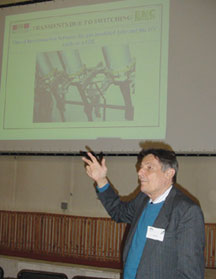 |
| Dr. Michel Ianoz, IEEE EMC Society
Distinguished Lecturer, gave a presentation to the St. Petersburg
Chapter. |
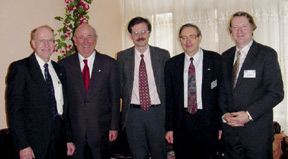 |
| IEEE President Michael Adler, 2001
IEEE President Joel Snyder, Saint-Petersburg BT/CAS/COM Chapter
Chair Dmitry Tkachenko, IEEE Russia (Northwest) Section Vice
Chair Alexander Mikerov, and EMC Coordinator of the AES/IE/C/EMC/PE
Joint Chapter, Alexander Worshevsky, (from left) are shown
during the 5th International Symposium on Electromagnetic
Compatibility and Electromagnetic Ecology in St. Petersburg. |
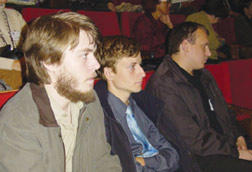 |
| The Plenary Session of the 5th International
Symposium on Electromagnetic Compatibility and Electromagnetic
Ecology featured young specialists Anton Worshevsky, Peter
Worshevsky, and Alexey Agofonov (from left). |
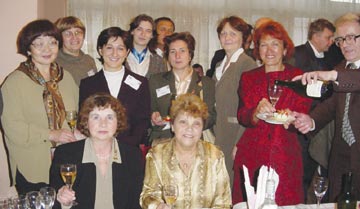 |
| Beautiful participants celebrate
the success of the 5th International Symposium on Electromagnetic
Compatibility and Electromagnetic Ecology in St. Petersburg. |
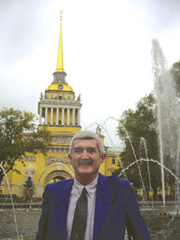 |
| Elya Joffe is shown during the City
Tour near the Admiralty in St. Petersburg. Mr. Joffe is the
“Angel” for the St. Petersburg Chapter. |
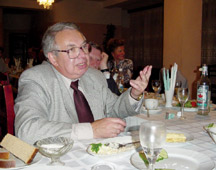 |
| Vice-Chairman of the symposium, Pavel
Asovich, is shown during the St. Petersburg conference banquet. |
Saint Petersburg (Russia)
Dr. Alexander Worshevsky from the IEEE
Saint Petersburg (Russia) AES/IE/C/EMC/PE Joint Chapter reported
on the 2003 activities of the Chapter. A new IEEE Section was
formed on February 13 in Russia. The IEEE Russia (Northwest) Section
encompasses 156 Members, (including eight Senior Members and 36
student members), eight Chapters and the Student Branch. The chapter
is especially proud that the Chairman of the AES/ IE/C/EMC/PE
Joint Chapter, Professor Alexander Mikerov, was elected as Vice
Chair of the IEEE Russia (Northwest) Section. The Saint-Petersburg
AES/IE/C/ EMC/PE Joint Chapter organized the Annual Scientific
Conference of IEEE members on June 11. 17 papers, presented in
English, were published in the Proceedings 2003 of the St. Petersburg
Chapter. The innovative and future looking direction was evident
in the exciting video and audio presentation of Professor Alexander
Gelman (Communication Society Vice-Chair) about the fabulous perspectives
of a global communications development. Dr. Michel Ianoz, EMC
Society Distinguished Lecturer and Honorary Professor of the Swiss
Federal Institute of Technology, Lausanne, Switzerland gave excellent
lectures for IEEE members and EMC specialists on September 11-12
on the topics: “EMC problems related to transient phenomena
in the power network substations” and “Protection concepts
and protection solutions for lines, cables, and circuits submitted
to disturbance electromagnetic fields.” The 21 participants
asked many questions. They discussed some technical solutions
(for example, cable grounding) and agreed upon the importance
of the topics for the EMC practice. Michael Alder, the 2003 IEEE
President and Joel Snyder, the 2001 IEEE President, visited the
Saint Petersburg Chapter on September 13-18. They met with AES/IE/C/EMC/PE
Joint Chapter Chair Professor Alexander Mikerov and other Saint-Petersburg
IEEE members. Mr. Alder and Mr. Snyder were in attendance at the
opening session of the 5th International Symposium on Electromagnetic
Compatibility and Electromagnetic Ecology. The IEEE President
and Past President held a meeting with the IEEE Section Conference
Committee devoted to the potential of future IEEE international
conferences in St. Petersburg. They encouraged the IEEE Societies
to sponsor such future symposia in Russia. The 5th International
Symposium on Electromagnetic Compatibility and Electromagnetic
Ecology was held in Saint Petersburg on September 16-19, co-sponsored
by the IEEE Saint Petersburg AES/IE/C/EMC/PE Joint Chapter. The
venue of the symposium was the Saint Petersburg Electrotechnical
University “LETI”. The Saint-Petersburg Electrotechnical
University, Scientific and Technical Society of Radio Engineering,
Radio Research and Development Institute and “Diskon-center”
organized the event. IEEE members from Israel, Japan, Switzerland,
Poland, and Germany were also members of the organizing and program
committees. Professor V. Kutuzov was the chair of the organizing
committee and chairman of the symposium. Official languages were
English and Russian. Translation was organized at every session.
EMC 2003 was dedicated to the 300-year anniversary of Saint Petersburg.
Peter the Great founded the city in 1703. Leaders of many countries
participated in the anniversary event in June 2003. Here are some
statistics from the EMC Symposium 2003 in Saint Petersburg:
-
International participants:
23
-
Local participants:
98
-
Plenary session (meeting):
1
-
Topical Sessions:
12
-
Total number of sessions:
19
-
Total number of published
papers: 138
-
Number of oral paper
presentations: 116
The presentation of ‘distance education’
with virtual EMC labs by Professor L. Kechiev was one of the most
interesting paper presentations at the educational sessions. Sessions
on test equipment and certification led participants to a long
discussion about the improvement of EMC requirements and the present
practice of EMC standardization. The Biological Effects session
was interesting for all participants. Professor N. Korovkin and
colleagues presented several papers about new investigation methods
in EMC such as fractal analysis and genetic method. Attendees
came from Belorus, Canada, Finland, Germany, Israel, Italy, Japan,
Netherlands, Poland, Russia, Ukraine and Switzerland. The tourist
program included a city tour, a cruise over the river Neva, a
visit to the Peterhof palace and famous fountains, situated 25
km from the city, and an excursion to the Hermitage Museum. In
their spare time, participants could choose from more than 20
art museums, 11 palaces and parks, 28 literature, music and theatre
museums, 32 technical museums, 11 army and navy museums, and many
historical, cultural places of interest and exhibitions. In the
evening, they could also visit more than 20 theatres. It was a
very hard choice! The Organizing Committee has already begun work
on the 2005 Saint Petersburg EMC Symposium. Volunteers are invited
to sign-up and help. Elya Joffe, our EMC Chapter “Angel”,
and Vice-President for Conferences and Symposia of the IEEE EMC
Society, also visited Saint Petersburg on September 15-20, and
participated in the 5th International Symposium on Electromagnetic
Compatibility and Electromagnetic Ecology. In the session on EMC
Education, Elya presented a lecture on the principle of “Path
of Least Inductance” as a basis for understanding grounding
at high frequencies. The presentation was made in front of a forum
of EMC lecturers and specialists from universities and institutes.
More than 20 participants agreed that Elya's lecture was the best
example of a student education lecture (the example being how
to give a lecture on this basic concept). His combination of color
pictures, nonstandard ideas and a good presentation with humor
provided excellent results.
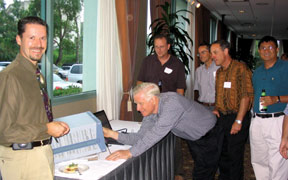 |
| Following the seminar in San Diego,
the speakers conducted a demonstration of the material presented.
James Young (far left) is happy to provide a demonstration
to the chapter members, including Rolando Velbis of Hitachi
Home Electronics (far right). |
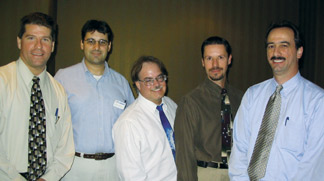 |
| Mark Frankfurth of Cymer, Chairman
of the San Diego Chapter (center), with the speakers from
the seminar “How to Improve the Accuracy of EMC Measurements”
including (from left) Rodger Gensel of Amplifier Research,
Vince Rodriguez of ETS-Lindgren, James Young of Rohde &
Schwarz, and Ray Adams of Boeing Satellite Systems. |
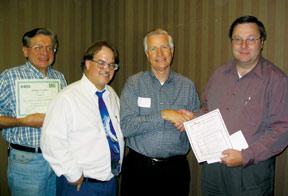 |
| A raffle was held upon the conclusion
of the San Diego Chapter seminar and all attendees received
certificates of completion. Paul Rostek of Teradata proudly
shows his certificate, while Mark Frankfurth, Dave Bernardin,
IEEE San Diego Section Chairman, and John Whitney of Amplifier
Research (from left) celebrate John’s win of a Fry’s
gift certificate. |
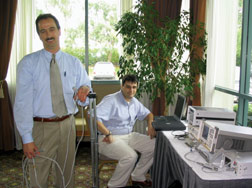 |
| Ray Adams (left) and Vince Rodriguez
set up a demonstration table prior to the start of the San
Diego Chapter half-day seminar. |
San Diego
The San Diego EMC Chapter presented “How
to Improve the Accuracy of EMC Measurements,” a half-day
technical seminar on September 23 at the Wyndham Hotel. The seminar
featured several speakers, including Los Angeles Chapter Chair
Ray Adams of Boeing Satellite Systems. In fact, it was Chair Ray
Adams that conceived the technical program and who volunteered
to take “the show on the road” to his sister EMC chapter
in San Diego. (In reality, Mr. Adams was looking for a venue to
do a dress rehearsal of the seminar before it was presented to
the “real” audience, his chapter, in Los Angeles two
days later!) The seminar began after lunch with a kick off presentation
by Rodger Gensel of Amplifier Research who spoke on RF Conducted
and Transient Disturbance Testing. Next, Ray Adams spoke on the
topic Radiated Susceptibility/Immunity. Vince Rodriguez of ETS-Lindgren
then addressed Wireless EMC and finally, James Young of Rohde
& Schwarz discussed Radiated Emissions. Mark Frankfurth of
Cymer Corporation, Chair of the San Diego Chapter, was on hand
to present attendees with “official” certificates of
completion. Also present was the IEEE San Diego Section Chair,
Dave Bernardin of Hewlett Packard. Dave was the immediate past
chair of the San Diego EMC Chapter and has moved on to bigger
and better IEEE volunteer work! A reception was held following
the seminar with the speakers each conducting demonstrations of
the material presented. Attendees were treated to heavy appetizers
and drinks courtesy of Amplifier Research, ETS-Lindgren, Rohde
& Schwarz, and Altamont Technical Sales. This provided a wonderful
opportunity to informally visit with the speakers, view demonstrations
and enjoy good food and drink. Unfortunately, the hotel did not
yet have its liquor license so the “drink” was brought
in from the neighborhood Costco. Over 70 chapter members and guests
attended the seminar.
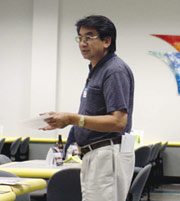 |
| Bert Chan from Foundry Networks addresses
the Santa Clara Chapter on the technical program activities
at the Boston Symposium. |
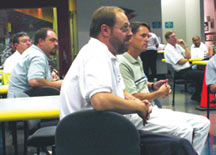 |
| Jerry Ramie, Mike Kriege and others
listen to Bert Chan’s presentation. |
 |
| The Steering Committee for the 2004
IEEE International Symposium on EMC in Santa Clara is hard
at work planning for the big event next summer! |
Santa Clara Valley
Darryl Ray reports the Santa Clara Valley
chapter took June through August off from the monthly meetings
for a well-deserved summer recess. Monthly meetings resumed in
September with the annual chapter social. The social was held
at Applied Materials in Santa Clara, California. The 31 attendees
enjoyed food and drinks while engaging in lively discussions.
Bert Chan from Foundry Networks presented the highlights from
the Boston symposium at the meeting. Bert is on the technical
program committee for the 2004 IEEE International Symposium on
EMC in Santa Clara and he outlined several ideas for the workshops
and technical sessions aiming to focus on the basics in order
to help the EMC practitioner perform his or her job. Speaking
of EMC 2004, the Steering Committee has been going full throttle
this summer planning the Santa Clara symposium. Monthly meetings
are held at Apple Computer in Cupertino, California. The committee
is aiming to put on an excellent symposium. The call for papers
ends October 15. Start dropping hints to your boss now and we
hope to see you in Santa Clara next August!
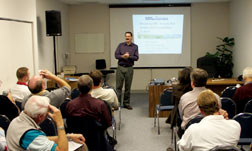 |
| Seattle Chapter Chairman Pat André
addresses the crowd at the September Chapter meeting. |
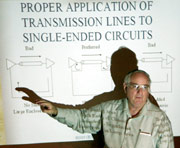 |
| Chris Kendall of CKC Labs, EMCS Distinguished
Lecturer, gave an entertaining and educational presentation
to the Seattle Chapter in September. |
Seattle
The Seattle EMC Chapter took the summer
months off and resumed activity with their September 30 meeting
held at CKC Labs in Redmond, Washington. EMC Society Distinguished
Lecturer, Chris Kendall of CKC Labs, was the featured speaker.
Chapter Chairman Pat André of André Consulting opened
the meeting by sharing fond memories of his early days in EMC
when he worked for Chris Kendall. Chris’s presentation was
notable for his “professor” quality presentation style,
his thorough knowledge of the subject matter, and his witty humor.
Some 23 people attended his presentation entitled “EMC Design
Considerations for Military Systems Utilizing High Speed Commercial
Interfaces Such As USB, Firewire, 100 BaseT, DVI, and SERDES”.
The topic was originally focused on military and aerospace applications
of these interfaces. However, since most of the attendees were
interested in the commercial application of data interfaces, Mr.
Kendall quickly changed direction and spoke to the audience’s
needs. With many whiteboard illustrations and humorous stories
of past EMI issues, Mr. Kendall was able to communicate many concepts
for us to use. While the presentation at just under two hours
was longer than the typical monthly meeting presentation, the
hardy chapter members hung on to every word, and even stayed longer
to ask questions! All present appreciated Chris’s visit to
the Pacific Northwest. The Chapter looks forward to an exciting
line up of speakers for its October and November meetings, time
off for the holidays in December, and an excellent one day tutorial
and exhibition on January 20, 2004 called “The Bruce Lee
EMC Show” with industry gurus, Bruce Archambeault of IBM
and Lee Hill of Silent Solutions, being the head line speakers.
Check out Seattle EMC Chapter activities on the Seattle Section
website at www.ieee-seattle.org.
Please visit us if you happen to be in the Seattle area when a
Chapter meeting is held.
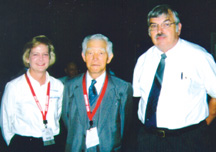 |
| Janet O’Neil and Clayton Paul
flank Risaburo Sato (center) at the Boston EMC Symposium.
Dr. Sato is the chair of the Sendai EMC Chapter. |
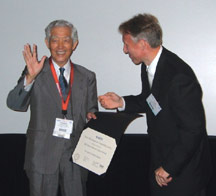 |
| Dr. Sato (left) receives an IEEE
EMCS award for “Chapter of the Year” presented by
Todd Hubing, President of the EMC Society, at the Boston EMC
Symposium. |
Sendai
The Sendai chapter was very lucky to receive
the “Chapter of the Year Award” at the 2003 IEEE Symposium
on EMC in Boston last August. At the Awards Luncheon, our Chapter
Chair Professor Sato received the award with great pleasure and
honor. The Sendai Chapter was formed in 2001 and consists of 33
members. They hold a couple of regular and technical meetings
every year. The current main target of their activities is to
make a successful start of the symposium, EMC’04/Sendai (https://www.ieice.org/emc04/).
The Sendai Chapter members sincerely hope that many people will
come to Sendai next June to share their academic and technical
knowledge and to enjoy the natural environment and various historic
places in the area.
Southeastern Michigan
On September 17, EMC Society Distinguished
Lecturer Dr. Bruce Archambeault presented “Reducing Emissions
Through PCB Layout and Effective Power/Ground Plane Decoupling.”
There were 44 attendees at this meeting held at the University
of Michigan Dearborn (UMD) Campus, which included several people
who had attended the SAE EMI Standards Committee meeting held
there just prior to the chapter meeting. Mark Steffka, Adjunct
Lecturer of Electrical and Computer Engineering at UMD, was our
host for the meeting, held in the Professional Education Center.
Don Yordy, local representative from CMP, provided the pizza,
chips and refreshments for the attendees. Chapter Chair Scott
Lytle was the presiding officer at the meeting. Dr. Archambeault
discussed real-world examples of measurements, as well as computer
simulations, which were used to demonstrate the optimal decoupling
strategy. Successful routing of all these signals often requires
some of the standard EMC “rules” to be violated. However,
not all of these EMC rules are equal, that is, some are more important
than others. Many graphs were presented summarizing the various
experiments conducted to illustrate the effects of decoupling
capacitors on multi layer printed circuit boards. A copy of the
presentation slides may be viewed at https://www.ewh.ieee.org/r4/se_michigan/emcs/bruce.htm.
Dr. Archambeault is a Senior Technical Staff Member at IBM in
Research Triangle Park, North Carolina. He received his BSEE degree
from the University of New Hampshire in 1977 and his MSEE degree
from Northeastern University in 1981. He received his PhD from
the University of New Hampshire in 1997. His doctoral research
was in the area of computational electromagnetics applied to real-world
EMC problems.
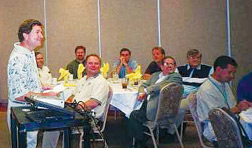 |
| Curt Sponberg, chair of the local
Twin Cities Chapter, addresses the 40 or so attendees at the
annual “EMC Event.” |
 |
| Bruce Archambeault demonstrates his
“Grounding Myths” to the attentive Twin Cities Chapter
at their noon meeting held on September 16 in a suburb of
Minneapolis. |
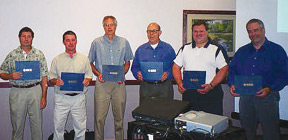 |
| Members of the 2002 IEEE International
Symposium on EMC local planning committee received their certificates
of appreciation at the Twin Cities Chapter meeting, including
(from left) Curt Sponberg and Joel Peltier of Medtronic, John
Maas of IBM, Greg Lawrence of United Defense, Brodie Pedersen
of Nonin, and Phil Tuckner of TUV America. |
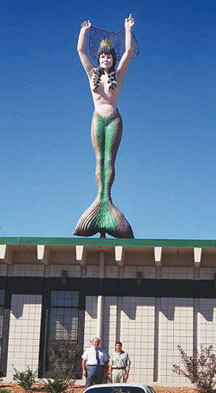 |
| Bruce Archambeault (left) and Curt
Sponberg are shown in front of the world-famous Mermaid restaurant
- bowling alley - conference center - hotel - bar complex. |
Twin Cities
On September 16, 45 members and guests
gathered for a lunch meeting to hear EMC Society Distinguished
Lecturer Bruce Archambeault give his “Grounding Myths”
presentation. The audience was attentive and Bruce’s presentation
was well received. On Monday, September 22 the annual EMC Event
was held featuring several technical sessions. Over 50 people
attended. Although this event has traditionally been set-up by
private parties, the local EMC chapter provided technical cooperation.
Members of the planning committee for the 2002 IEEE International
Symposium on EMC in Minneapolis received certificates of appreciation
for all of their hard work and dedication. Honored for their efforts
were Curt Sponberg and Joel Peltier of Medtronic, John Maas of
IBM, Greg Lawrence of United Defense, Brodie Pedersen of Nonin,
and Phil Tuckner of TUV America.
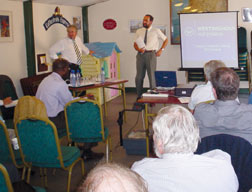 |
| Bob Edwards of Westinghouse gave
a presentation to the UK-Ireland Chapter at Didcot, complete
with a train balloon on the ceiling. |
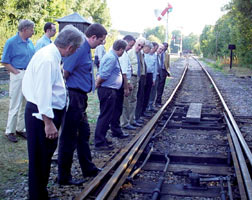 |
| Some of the UK-Ireland Chapter guys
are “on the right track” at Didcot. |
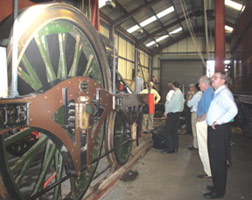 |
| Bob Plowman of Rolls Royce and Tony
Swainson a consultant (foreground left to right), inspect
a train undergoing restoration in an engine shed following
the UK-Ireland Chapter meeting. |
UK and Republic of Ireland
The Chapter has gone from one success to
another since it was re-launched early in 1999. Some four to six
meetings are held each year. These include technical presentations
on topics of current interest and, where possible, venues are
selected which have a broad appeal and can offer some more general
interest after the technical business. This year the first meeting
in March was on the theme of shielding and grounding and was hosted
by TECAN Components Ltd at Portland in Dorset. After the buffet
lunch, there was a fascinating conducted tour of Tecan’s
facility in Weymouth, Dorset. In June, a meeting on the theme
of automotive EMC was hosted by MIRA at Nuneaton in Warwickshire.
A live vehicle test was featured after the technical presentations.
Both meetings were well attended and the technical presentations
were of great interest. In September, a meeting on “EMC Measurement
Techniques and Railway EMC” inspired an excellent crop of
technical papers. The venue was the Didcot Railway Centre, which
is the home of the Great Western Society. A guided tour of the
centre was provided and everyone reveled in the beautifully restored
steam engines and rolling stock. There were also carefully preserved
station buildings and tracks from the very earliest times. The
enthusiasm was such that it was obvious that many EMC engineers
long for the days of steam when EMC had not even been born. EMC
|
|
|
 Chapter
Chatter
Chapter
Chatter 






































